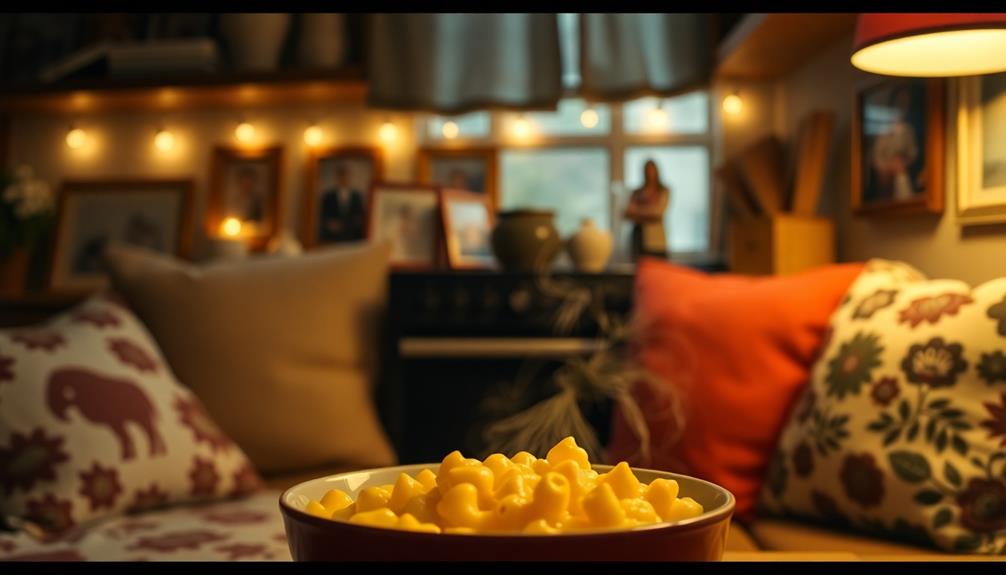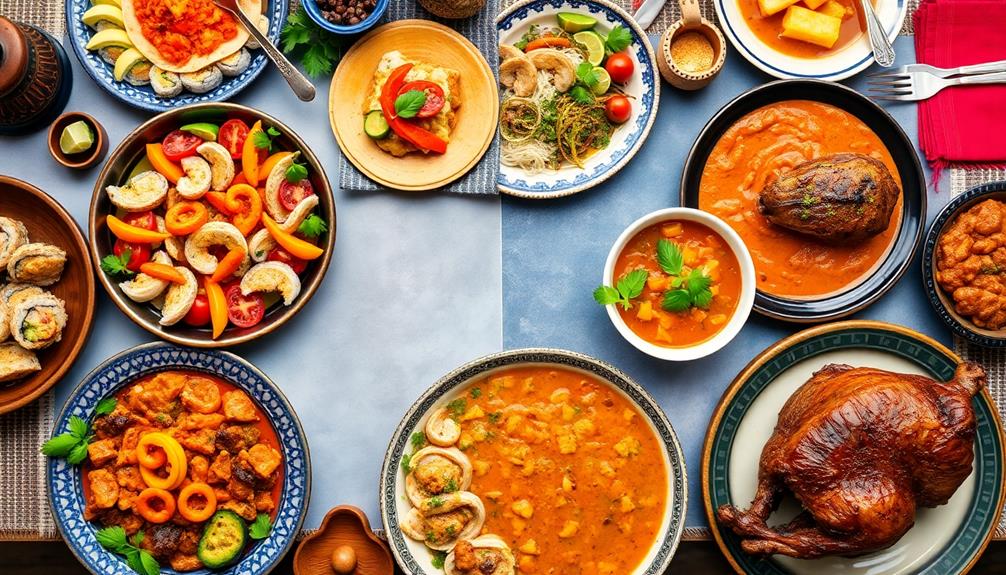To create a Pinterest-perfect home, you need to embrace the beauty of Indonesian textiles. Start with the Balinese Double Ikat, renowned for its vibrant patterns and handspun fabric. Traditional Batik, a UNESCO treasure, adds rich stories to your decor. Don't overlook Dayak Ethnic Patterns, which reflect deep ties to nature through unique geometric designs. Incorporate Borneo Pattern Design for a warm, authentic vibe inspired by local culture. Ultimately, contemporary textile trends blend modernity with traditional craft, making them perfect for any space. Stick around, and you'll discover even more textiles to elevate your home decor.
Key Takeaways
- Incorporate Balinese Double Ikat for its vibrant colors and sacred significance, perfect for adding warmth to your decor.
- Embrace Traditional Batik's intricate designs inspired by nature, ideal for versatile applications like cushions and table runners.
- Use Dayak Ethnic Patterns to reflect community stories and nature, enhancing your home with authentic, cultural motifs.
- Choose Borneo Pattern Design for its organic shapes and traditional symbolism, perfect for throw pillows and wall art.
- Explore Contemporary Textile Trends that combine eco-friendly materials with modern aesthetics, supporting ethical fashion while enhancing your home.
Balinese Double Ikat

When you explore the world of Indonesian textiles, you'll quickly discover the beauty of Balinese Double Ikat, or Kamben Geringsing. Originating from Tenganan Pegeringsingan, this textile isn't just a fabric; it's a symbol of cultural heritage that connects you to Bali's rich traditions.
The process involves a unique technique where both the warp and weft threads are dyed before weaving, resulting in stunning, intricate patterns that reflect the skill of the artisans. The vibrant colors and intricate designs of these textiles can also beautifully complement your home decor, adding a touch of authenticity and warmth. Incorporating Indonesian decorative pillows made from similar materials can enhance your living spaces even further.
Balinese Double Ikat is made from handspun cotton and dyed with natural dyes, showcasing a level of craftsmanship that's hard to find elsewhere. Each piece tells a story, often rooted in local beliefs and symbolism, making it more than just a decorative item for your home.
When you incorporate these textiles into your decor, you bring a sense of history and meaning into your space. Additionally, Balinese Double Ikat is often used in religious ceremonies, further emphasizing its sacredness.
Traditional Batik

Traditional Batik is a fascinating Indonesian textile art form that originates from Java, showcasing the intricate wax-resist dyeing technique that creates stunning, symbolic patterns.
Recognized by UNESCO as a Masterpiece of Oral and Intangible Heritage, Batik reflects the rich cultural heritage and craftsmanship of the Indonesian people.
Additionally, many Batik designs are inspired by nature and local folklore, making them a mesmerizing representation of Indonesian culture.
You'll find Batik plays a significant role in traditional ceremonies, making it a perfect addition to your home decor, especially when paired with affordable Indonesian decor masks that enhance the overall aesthetic.
Here are four ways to incorporate Traditional Batik into your living space:
- Batik Tulis Cushion Covers: Hand-drawn designs add a touch of uniqueness to your sofas.
- Batik Wall Hangings: Stunning peacock motifs can serve as eye-catching focal points.
- Table Runners: Use Batik patterns to create an elegant dining atmosphere during gatherings.
- Batik Scarves: These can double as decorative wall art or personal accessories, showcasing your appreciation for Indonesian textiles.
Dayak Ethnic Patterns

Explore the vibrant world of Dayak ethnic patterns, which originate from the indigenous Dayak people of Borneo. These intricate designs are rich in cultural heritage, showcasing geometric and organic motifs that tell the stories of the Dayak community.
You'll find that each pattern reflects a deep connection to nature and traditional symbolism, making them unique representations of the Dayak people's identity. Additionally, these patterns often resemble the bold designs seen in Indonesian decor masks, further emphasizing the cultural significance of artistry in this region.
Incorporating Dayak ethnic patterns into your home decor not only adds a striking visual element but also honors the artistry and values of this remarkable culture. These designs often appear in traditional clothing and ceremonial items, emphasizing their significance in the Dayak way of life.
Today, Dayak patterns are gaining traction in contemporary fashion and textile design. By choosing these textiles, you're supporting local artisans and promoting sustainable practices, while also enjoying the beauty of a rich cultural legacy.
Whether it's a throw pillow, wall hanging, or a piece of clothing, Dayak ethnic patterns can transform your space into a Pinterest-perfect haven that celebrates both style and substance. Embrace this unique blend of tradition and modernity for a truly distinctive touch in your home.
Borneo Pattern Design

Borneo pattern design captivates with its bold colors and unique shapes, reflecting the rich cultural heritage of the indigenous Dayak people. These vibrant motifs often draw inspiration from natural elements and traditional symbolism, making them not only visually striking but also culturally significant.
The designs echo the traditional Indonesian houses, known for their community-oriented layout and use of local materials, which further enhances the connection between culture and home decor. Incorporating Borneo patterns into your home décor can add a touch of authenticity and warmth to your space, creating an inviting atmosphere that celebrates cultural heritage traditional Indonesian houses.
Here are four ways to use Borneo pattern design in your home:
- Throw Pillows: Infuse your living room with energy by adding throw pillows featuring Borneo patterns.
- Wall Art: Hang prints that showcase these intricate designs to create a focal point in any room.
- Table Linens: Use table runners or placemats adorned with Borneo motifs for your dining experience.
- Textile Accents: Incorporate Borneo patterns in curtains or upholstery to enhance the overall aesthetic.
With their versatility, Borneo patterns can easily be adapted for various applications, including textiles, wallpapers, and digital graphics, making them a perfect choice for anyone looking to elevate their home décor.
Contemporary Textile Trends

Indonesian textiles are making waves in contemporary home decor, as their vibrant designs blend seamlessly with modern aesthetics. The fusion of traditional designs with innovative applications creates a unique appeal for today's consumers. With a rising demand for sustainable practices, many designers focus on eco-friendly materials and methods, ensuring that your decor is both stylish and responsible.
| Feature | Benefits | Examples |
|---|---|---|
| Traditional Designs | Rich cultural heritage | Batik, Ikat, Tenun |
| Handcrafted Textiles | Unique stories and character | Woven wall hangings, cushions |
| Sustainable Practices | Eco-conscious choices | Organic dyes, recycled materials |
Collaborations between local artisans and contemporary designers have led to an exciting array of handcrafted textiles that reflect Indonesia's rich cultural diversity. As you choose textiles for your home, consider how these pieces not only enhance your decor but also support ethical fashion movements. By embracing these contemporary trends, you'll create a Pinterest-perfect home that showcases beauty while honoring tradition and sustainability.
Frequently Asked Questions
What Is the Most Popular Textile of Indonesia?
The most popular textile in Indonesia is Batik. You'll love its intricate designs and cultural significance. Originating from Java, it features unique patterns that tell stories, making it a stunning addition to any collection.
What Is the Famous Fabric Design of Indonesia?
You won't believe the stunning beauty of batik, Indonesia's most famous fabric design! This intricate art form, with its mesmerizing patterns and rich symbolism, will captivate your heart and transform any space into a visual masterpiece.
What Is a Form of Textile Design From Indonesia?
One prominent textile design from Indonesia is batik. It features intricate patterns created through a wax-resist dyeing technique. You'll love its rich cultural significance and unique artistry, which reflect Indonesia's artistic heritage beautifully.
Is the Traditional Fabric of Indonesia?
Yes, Indonesia's traditional fabric includes batik and ikat, each showcasing unique techniques and cultural significance. You'll appreciate how these textiles embody rich stories and artistry, reflecting the diverse heritage of the Indonesian people.
Conclusion
Incorporating these stunning Indonesian textiles into your home isn't just about decor; it's about weaving a tapestry of culture and history into your daily life. From the vibrant Balinese Double Ikat to the intricate designs of Batik, each piece tells a story that can brighten any room. So, why settle for ordinary when you can transform your space into a Pinterest-perfect haven? Embrace these unique patterns and let your home become a canvas of creativity and tradition.









